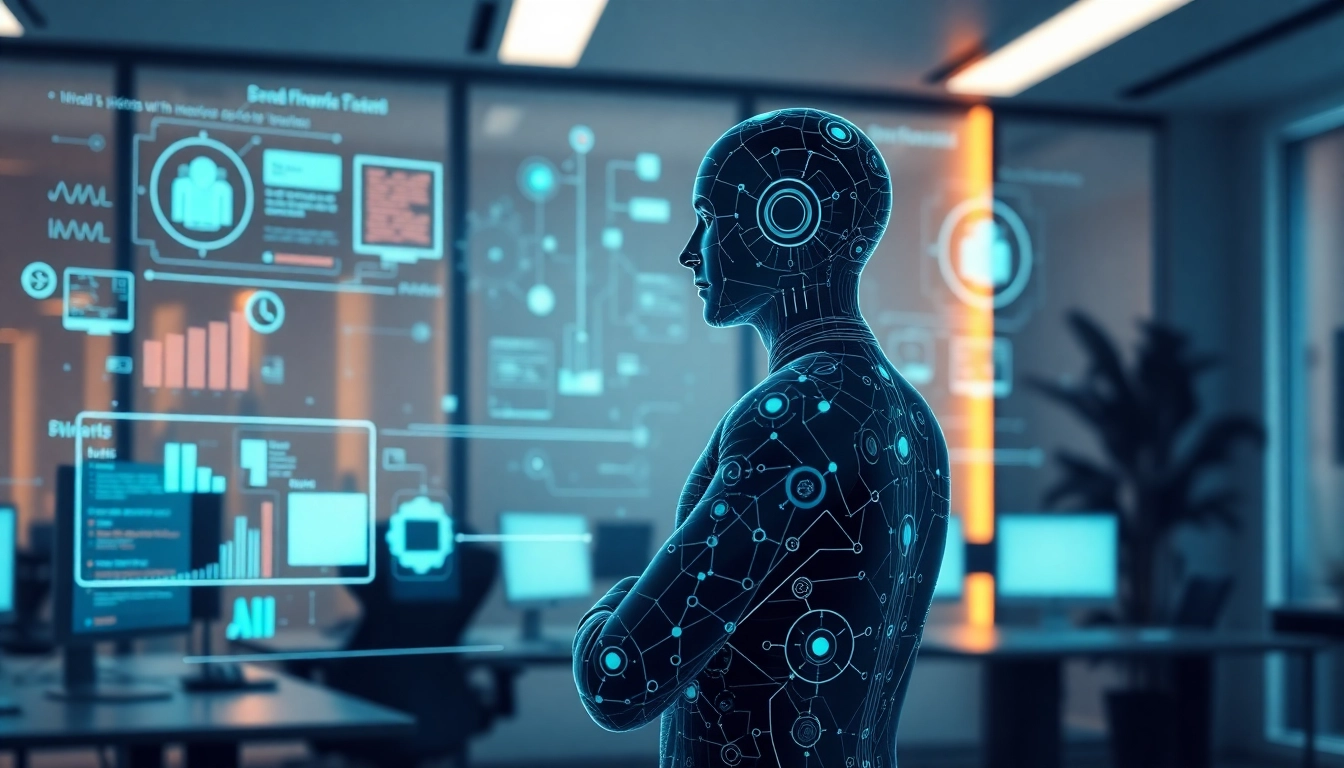Introduction to Agentic Human AI
The rise of artificial intelligence has ushered in a new era of capabilities, one that challenges traditional notions of autonomy and collaboration. Among the most exciting developments is Agentic Human AI, a term that encapsulates the essence of AI systems designed to operate independently, learn from their environments, and make decisions with minimal human oversight. This article delves into the intricacies of Agentic Human AI, exploring its definitions, evolution, and significance in our workplaces.
Definition and Key Concepts
Agentic Human AI refers to AI systems capable of taking autonomous actions toward defined goals without continuous human input. This definition hinges on several key concepts including autonomy, adaptability, decision-making, and collaboration. Unlike traditional AI systems, which often rely heavily on human instructions or pre-defined rules, agentic AI exhibits a higher level of intelligence and self-sufficiency.
Autonomy in Agentic Human AI indicates the system’s ability to execute tasks independently, often employing machine learning techniques to adapt to new situations dynamically. Adaptability represents how these AI systems can analyze changing conditions and refine their approaches accordingly. This is particularly vital in environments characterized by rapid evolution, such as business, healthcare, and logistics.
Additionally, decision-making in agentic AI extends beyond binary choices; it encompasses complex reasoning processes, allowing these systems to assess multiple variables before arriving at conclusions. Finally, collaboration emphasizes the partnership between humans and AI, where both entities contribute distinct capabilities to achieve shared goals.
The Evolution of AI Capabilities
The evolution of AI capabilities can be traced through several technological milestones, with each advancement building upon the last. In the early days of AI, systems relied heavily on rule-based algorithms that followed fixed programming instructions. However, as machine learning algorithms became more sophisticated, AI began to model complex patterns and make probabilistic predictions.
With the introduction of deep learning, AI systems gained unprecedented capabilities in areas such as image recognition, natural language processing, and even strategic game-playing. These advancements laid the groundwork for developing agentic AI, enabling systems to not only perform specific tasks but also improve their decision-making through experience.
Today, agentic AI is at the forefront of AI technology, incorporating advances in cognitive computing and neural networks that enable systems to process vast amounts of data and learn from it. This evolution has far-reaching implications, particularly in industries that seek to enhance efficiency and reduce operational costs.
Importance in Modern Work Environments
The integration of agentic AI into modern workplaces has the potential to redefine productivity and operational workflows. By taking over repetitive tasks and complex problem-solving, these systems free human workers to focus on higher-value activities, fostering creativity and strategic thinking.
Businesses are increasingly realizing the competitive advantages of implementing agentic AI solutions. For instance, in logistics, AI can optimize routing and inventory management in real-time, leading to significant cost savings and improved service levels. In healthcare, AI systems assist in diagnosing diseases with remarkable accuracy, enabling providers to offer timely and targeted treatments.
Moreover, the collaborative aspect of agentic AI enhances human capabilities without replacing human roles. This symbiotic relationship fosters an environment where technology amplifies human potential, leading to innovations that drive companies forward.
How Agentic AI Works
Mechanisms of Autonomy and Decision-Making
Agentic AI functions based on a combination of algorithms that allow these systems to process information, analyze outcomes, and make decisions. Key mechanisms include machine learning, neural networks, and reinforcement learning.
Machine learning algorithms are at the heart of agentic AI, enabling the system to learn from experience and improve over time. For instance, through supervised learning, the AI learns from labeled datasets, while unsupervised learning allows it to identify patterns without human intervention.
Neural networks, inspired by the human brain, simulate connections between nodes (neurons), facilitating the processing of complex data. This architecture enables agentic AI systems to recognize patterns within unstructured data, such as text or images.
Reinforcement learning takes this a step further; systems learn through trial and error, receiving feedback in the form of rewards or penalties based on their decisions. This iterative process allows agentic AI to optimize its strategies, making it particularly adept in environments that require adaptability and strategic thinking.
Examples of Agentic AI Applications
Agentic AI is already transforming various sectors, with numerous applications showcasing its capabilities. In finance, for example, AI-powered trading algorithms analyze market trends to execute trades autonomously, maximizing returns while minimizing risks. These systems can react to market changes in real-time, demonstrating efficiency that surpasses human traders.
In manufacturing, predictive maintenance systems use agentic AI to anticipate equipment failures before they happen, thereby reducing downtime and saving costs. By continuously monitoring machinery and analyzing performance data, these AI systems can make suggestions for repairs or adjustments, optimizing operational efficiency.
Healthcare applications are particularly notable. AI systems assist radiologists by automatically identifying anomalies in medical images, leading to quicker and more accurate diagnoses. Similarly, patient management systems utilize agentic AI to personalize treatment plans based on historical data and evolving patient conditions.
Benefits for Efficiency and Productivity
The integration of agentic AI into organizational workflows presents substantial benefits in efficiency and productivity. One of the primary advantages is the reduction of time spent on routine tasks. By automating these tasks, businesses can reallocate their human resources to areas requiring creativity and critical thinking.
Agentic AI also enhances decision-making capabilities by providing data-driven insights. With the ability to analyze extensive datasets quickly, these systems can uncover trends and patterns that humans may overlook. This leads to informed strategic decisions that can significantly impact organizational success.
Moreover, agentic AI systems can operate around the clock, providing continuous support and engagement. This aspect is particularly beneficial in industries such as customer service, where AI can manage inquiries, troubleshoot issues, and gather feedback without rest, ultimately improving customer satisfaction.
Challenges and Considerations
Ethical Implications of Autonomy
While the benefits of agentic AI are substantial, they bring forth ethical considerations that necessitate careful examination. The autonomy of AI systems raises questions about accountability and the potential for unintended consequences. For instance, if an AI-driven system makes a decision that leads to a detrimental outcome, who bears responsibility? The complexity of determining liability complicates ethical deliberations surrounding agentic AI.
Moreover, the reliance on data can introduce biases, affecting the fairness and integrity of decisions made by AI systems. It is crucial to ensure that the data used to train these models is diverse and representative to mitigate the risk of exacerbating existing inequalities.
Additionally, transparency in the decision-making processes of agentic AI systems is essential. Stakeholders must understand how these systems arrive at their conclusions to foster trust and accountability in AI applications.
Data Handling and Privacy Issues
Data handling within agentic AI systems poses significant challenges, particularly concerning user privacy and data security. As these systems often require access to vast amounts of sensitive information, robust security measures are essential to protect against breaches and unauthorized access.
Regulatory compliance also presents a challenge. Businesses must adapt their practices to align with legislation such as GDPR and CCPA, which impose strict guidelines on data collection, storage, and usage. Failure to comply can result in legal repercussions and damage to reputations.
In addition, organizations must establish protocols for data management that adhere to ethical standards, ensuring that individuals’ personal information is used responsibly and transparently.
Addressing Misconceptions and Risks
Misconceptions around agentic AI can hinder its adoption and integration within organizations. A common myth is that agentic AI will entirely replace human workers. In reality, the objective is to augment human capabilities by taking over mundane tasks and enabling employees to focus on more strategic initiatives.
Furthermore, organizations must recognize the potential risks associated with AI deployment, such as dependency on technology and job displacement. To address these concerns, leaders must foster a culture of continuous learning and adaptation, equipping employees with the skills needed to work alongside AI systems effectively.
Investing in training programs that emphasize the role of AI in enhancing human performance is crucial for alleviating fears and ensuring a collaborative environment between technology and personnel.
Future of Agentic Human AI
Trends Shaping the Future Landscape
As Agentic Human AI continues to evolve, several trends are shaping its future landscape. One significant trend is the increasing emphasis on explainability and transparency in AI systems. Stakeholders, including consumers and regulators, are demanding clarity regarding how AI systems operate and make decisions.
Another trend is the growing interest in AI ethics. Organizations are beginning to establish ethical frameworks to guide their AI practices, ensuring responsible development and deployment of agentic AI technologies.
Moreover, the rise of edge computing is influencing the development of agentic AI systems. By processing data closer to the source rather than relying on centralized cloud infrastructures, edge computing enhances real-time decision-making capabilities and reduces latency.
Potential for Integration Across Industries
The potential for integrating agentic AI across various industries is vast. Sectors such as healthcare, finance, manufacturing, and retail are already exploring innovative applications that leverage agentic AI’s capabilities.
In agriculture, for instance, AI systems can monitor crop health and automate irrigation, leading to improved yields and sustainable practices. In transportation, autonomous vehicles are advancing rapidly, utilizing agentic AI to navigate safely and efficiently.
The additional applications of agentic AI extend to educational platforms, where personalized learning experiences can be tailored to individual student needs based on performance data. This transformative potential reinforces the necessity for organizations to explore agentic AI solutions to stay competitive in their respective markets.
Preparing for the AI-Driven Revolution
As we progress further into the AI-driven revolution, it is vital for organizations and individuals alike to prepare adequately. Businesses must adopt a proactive approach to training their workforce, instilling adaptability and a growth mindset essential for flourishing in an AI-integrated environment.
Furthermore, leaders should actively engage in discussions on AI ethics, fostering an organizational culture that prioritizes responsible and ethical AI practices. This establishes a foundation for trust and confidence among stakeholders, paving the way for smoother AI adoption.
In addition, collaboration between AI researchers, policymakers, and business leaders is necessary to create guidelines that foster innovation while maintaining ethical standards in AI deployment.
Conclusion and Call to Action
Embracing Change in Technology
The advent of agentic AI represents a pivotal moment in technology, offering unprecedented opportunities for enhancing human potential and operational efficiency. However, leveraging these advancements requires a commitment to ethical practices, continuous learning, and collaboration between humans and machines.
As we stand on the brink of an AI-driven future, it is imperative for organizations to embrace change, adapt to the evolving landscape, and integrate agentic AI solutions thoughtfully and strategically.
Ways to Get Involved and Educate
Individuals interested in harnessing the power of agentic AI can start by pursuing education and training in AI technologies, machine learning, and data analysis. Online courses and certifications are readily available, offering pathways to develop the skills necessary for a future intertwined with AI.
Moreover, attending workshops, conferences, and community events focused on AI is a great way to engage with experts in the field and remain informed about emerging trends and best practices.
Encouraging Collaboration Between AI and Humans
Organizations must cultivate a culture of collaboration between AI technologies and human employees. By promoting interdisciplinary teams that include AI specialists and end-users from various functions, businesses can streamline AI integration and foster innovation.
Emphasis on communication, feedback mechanisms, and shared objectives will enhance collaboration, allowing humans and AI to work together synergistically to address complex challenges and seize new opportunities.








